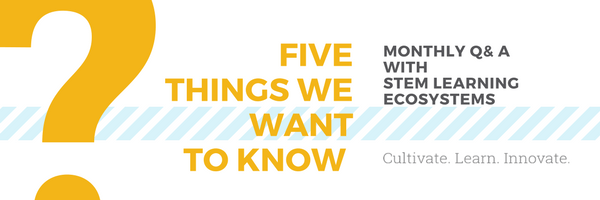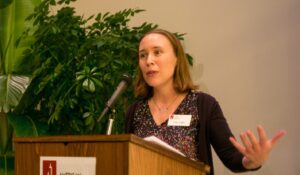 An Interview with Emily Dilger, PhD, Coordinator, Bay Area STEM Ecosystem
An Interview with Emily Dilger, PhD, Coordinator, Bay Area STEM Ecosystem
 This month’s Connections Newsletter features Dr. Emily Dilger, Bay Area STEM Ecosystem Coordinator, a master at leveraging those relationships for knowledge and program development.
This month’s Connections Newsletter features Dr. Emily Dilger, Bay Area STEM Ecosystem Coordinator, a master at leveraging those relationships for knowledge and program development.
What’s your background?
I grew up on Long Island and went to Mary Washington College, a small state school in Fredericksburg, Virginia, where I majored in biochemistry. After college I worked at Georgetown University for a few years before going to grad school, where I got my PhD in neuroscience from Virginia Commonwealth University. During grad school I volunteered at the Science Museum of Virginia — an experience which led me to leave academia and go into science education. I got a job at the Society for Neuroscience, a scientific membership organization in DC, where I ran informal science education programs for a range of audiences, from students and teachers to legislators and the media. I also managed BrainFacts.org, a site with credible and accessible information about the brain. After some time at the American Society for Microbiology, where I taught scientists to communicate with the public, I wound up in the San Francisco area and with the Bay Area STEM Ecosystem. Outside of work, I bake birthday cakes for underprivileged kids through a volunteer program. And I love hiking with my dog.
Tell us a little more about your role and focus in the Bay Area STEM Ecosystem.
I’m the coordinator of the Bay Area STEM Ecosystem. We are focusing on equity and access to STEM-rich learning opportunities for all youth in South San Francisco — which is its own separate city south of San Francisco and north of Silicon Valley. I spend half my time at the California Academy of Sciences, and the other half at the South SF Community Learning Center.
How do you see this program helping solve the employment gap and meet demand for STEM jobs?
We are providing students with the opportunity to explore real-world applications of STEM relevant to their own lives. This leads to the development of skills like problem solving, collaboration, and creativity — skills that would be a benefit in any career. Furthermore, these early STEM experiences can shape a child’s identity as someone capable of succeeding in a STEM career.
How is your group benefiting from its involvement in STEM Ecosystems?
Honestly, the most important part of the Ecosystem has been getting all the right people in the same room together. Our group is so busy doing amazing work that our quarterly meetings are often the only time they see each other. And when we provide time to network, the connections just flow!
Do you have a mentor? Who and how?
I’m going to say my mentor was the entire Summer 2001 community at Friday Harbor Labs, a marine biology lab of the University of Washington out in the Puget Sound. I worked there as a research assistant (did you know snails have teeth?). It was an incredible community where everyone, regardless of their seniority, was viewed as a scientist. Tenured faculty would engage me, a lowly 19-year-old college kid, in real science conversations. My knowledge was respected, which encouraged me to learn even more.
